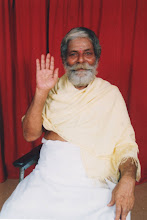Pathanjali's Yoga Sutras, Samadhi pada
We have seen all five types of thoughts of our mind. Now we will find out how can these thought-waves can be controlled. One main thing to remember: controlling should not be done forceably. If it is forceably suppressed, it will pop-out with more and more energy and increased in number and gives more torture to the mind. So here Pathanjali is giving following solutions for this.
Sutra 12: 'Abhyasa vairagyabhyam tath nirodhah'
They(thought-waves) are controlled by means of practice and non-attachment.
Sutra 13: 'Tatra sthithou yathno abhyasah'
Practice is the repeated effort to follow the disciplines which give permanent control of the thought-waves of the mind.
Sutra 14: 'Sa thu Dheerga kala nairantharya satkara sevitho drudabhoommmih'
Practice becomes firmly grounded when it has been cultivated for a long time, uninterruptedly, with earnest devotion.
Sutra 15: 'Drushtanushravika vishayavitrushnasya vasheekaara sanjna vairagyam'
Non-attachment is self-mastery; it is freedom from desire for what is seen or heard.
Explanations:
The waves of the mind can be made to flow in two opposite directions- either toward the objective world ("the will to desire") or toward true self knowledge("the will to liberation"). Therefore for the beginners of Yoga/Meditation, both Practice and Non-attachment are necessary. In Bhagavadgita, when Arjuna asked this same question, 'How to control the thought-waves of the mind?' Krishna gives the same answer that, "only through Practice and non-attachment". Thus the solution is the universal one.
Only we need to involved in practice and non-attachment, with awareness. This is the key point.
The spiritual disciplines which are to practice will be discussed in next chapter. They are known as the eight "limbs" of Yoga (Ashtanga Yoga: Yama, Niyama, Pranayama etc).
Non-attachment is the exercise of discrimination. We gradually gain control of the 'painful' or impure thought-waves by asking ourselves: "Why do I really desire that object? What permanent advantages should I gain by possessing it? In what way would its possession help me toward greater knowledge and freedom?" The answers to these questions are always disconcerting. They show us that the desired object is not only useless as a means to liberation but potentially harmful as a means to ignorance and bondage; and further, that our desire is not really desire for the object-in-itself at all, but only a desire to desire something, a mere restlessness in the mind. It is fairly easy to reason all this out in a calm moment.
The practice of non-attachment gives value and significance to even the most ordinary incidents of the dullest day. It eliminates boredom from our lives. And as we progress and gain increasing self-mastery, we shall see that we are renouncing nothing that we really need or want; we are only freeing ourselves from imaginary needs and desires.
Thankful to Existence,
Savita

No comments:
Post a Comment